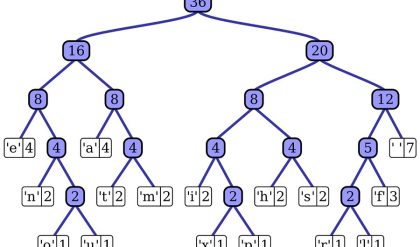Prerequisite: Asymptotic Notations
Assuming f(n), g(n) and h(n) be asymptotic functions the mathematical definitions are:
1. If f(n) = Θ(g(n)), then there exists positive constants c1, c2, n0 such that 0 ≤ c1.g(n) ≤ f(n) ≤ c2.g(n), for all n ≥ n0
2. If f(n) = O(g(n)), then there exists positive constants c, n0 such that 0 ≤ f(n) ≤ c.g(n), for all n ≥ n0
3. If f(n) = Ω(g(n)), then there exists positive constants c, n0 such that 0 ≤ c.g(n) ≤ f(n), for all n ≥ n0
4. If f(n) = o(g(n)), then there exists positive constants c, n0 such that 0 ≤ f(n) < c.g(n), for all n ≥ n0
5. If f(n) = ω(g(n)), then there exists positive constants c, n0 such that 0 ≤ c.g(n) < f(n), for all n ≥ n0
Properties:
1. Reflexivity:
If f(n) is given then
f(n) = O(f(n))
Example:
If f(n) = n3 ⇒ O(n3)
Similarly,
f(n) = Ω(f(n))
f(n) = Θ(f(n))
2. Symmetry:
f(n) = Θ(g(n)) if and only if g(n) = Θ(f(n))
Example:
If f(n) = n2 and g(n) = n2 then f(n) = Θ(n2) and g(n) = Θ(n2)
Proof:
· Necessary part:
f(n) = Θ(g(n)) ⇒ g(n) = Θ(f(n))
By the definition of Θ, there exists positive constants c1, c2, no such that c1.g(n) ≤ f(n) ≤ c2.g(n) for all n ≥ no
⇒ g(n) ≤ (1/c1).f(n) and g(n) ≥ (1/c2).f(n)
⇒ (1/c2).f(n) ≤ g(n) ≤ (1/c1).f(n)
Since c1 and c2 are positive constants, 1/c1 and 1/c2 are well defined. Therefore, by the definition of Θ, g(n) = Θ(f(n))
· Sufficiency part:
g(n) = Θ(f(n)) ⇒ f(n) = Θ(g(n))
By the definition of Θ, there exists positive constants c1, c2, no such that c1.f(n) ≤ g(n) ≤ c2.f(n) for all n ≥ no
⇒ f(n) ≤ (1/c1).g(n) and f(n) ≥ (1/c2).g(n)
⇒ (1/c2).g(n) ≤ f(n) ≤ (1/c1).g(n)
By the definition of Theta(Θ), f(n) = Θ(g(n))
3. Transistivity:
f(n) = O(g(n)) and g(n) = O(h(n)) ⇒ f(n) = O(h(n))
Example:
If f(n) = n, g(n) = n2 and h(n) = n3
⇒ n is O(n2) and n2 is O(n3) then n is O(n3)
Proof:
f(n) = O(g(n)) and g(n) = O(h(n)) ⇒ f(n) = O(h(n))
By the definition of Big-Oh(O), there exists positive constants c, no such that f(n) ≤ c.g(n) for all n ≥ no
⇒ f(n) ≤ c1.g(n)
⇒ g(n) ≤ c2.h(n)
⇒ f(n) ≤ c1.c2h(n)
⇒ f(n) ≤ c.h(n), where, c = c1.c2 By the definition, f(n) = O(h(n))
Similarly,
f(n) = Θ(g(n)) and g(n) = Θ(h(n)) ⇒ f(n) = Θ(h(n))
f(n) = Ω(g(n)) and g(n) = Ω(h(n)) ⇒ f(n) = Ω(h(n))
f(n) = o(g(n)) and g(n) = o(h(n)) ⇒ f(n) = o(h(n))
f(n) = ω(g(n)) and g(n) = ω(h(n)) ⇒ f(n) = ω(h(n))
4. Transpose Symmetry:
f(n) = O(g(n)) if and only if g(n) = Ω(f(n))
Example:
If f(n) = n and g(n) = n2 then n is O(n2) and n2 is Ω(n)
Proof:
· Necessary part:
f(n) = O(g(n)) ⇒ g(n) = Ω(f(n))
By the definition of Big-Oh (O) ⇒ f(n) ≤ c.g(n) for some positive constant c ⇒ g(n) ≥ (1/c).f(n)
By the definition of Omega (Ω), g(n) = Ω(f(n))
· Sufficiency part:
g(n) = Ω(f(n)) ⇒ f(n) = O(g(n))
By the definition of Omega (Ω), for some positive constant c ⇒ g(n) ≥ c.f(n) ⇒ f(n) ≤ (1/c).g(n)
By the definition of Big-Oh(O), f(n) = O(g(n))
Similarly,
f(n) = o(g(n)) if and only if g(n) = ω(f(n))
5. Since these properties hold for asymptotic notations, analogies can be drawn between functions f(n) and g(n) and two real numbers a and b.
· g(n) = O(f(n)) is similar to a ≤ b
· g(n) = Ω(f(n)) is similar to a ≥ b
· g(n) = Θ(f(n)) is similar to a = b
· g(n) = o(f(n)) is similar to a < b
· g(n) = ω(f(n)) is similar to a > b
6. Observations:
max(f(n), g(n)) = Θ(f(n) + g(n))
Proof:
Without loss of generality, assume f(n) ≤ g(n), ⇒ max(f(n), g(n)) = g(n)
Consider, g(n) ≤ max(f(n), g(n)) ≤ g(n)
⇒ g(n) ≤ max(f(n), g(n)) ≤ f(n) + g(n)
⇒ g(n)/2 + g(n)/2 ≤ max(f(n), g(n)) ≤ f(n) + g(n)
From what we assumed, we can write
⇒ f(n)/2 + g(n)/2 ≤ max(f(n), g(n)) ≤ f(n) + g(n)
⇒ (f(n) + g(n))/2 ≤ max(f(n), g(n)) ≤ f(n) + g(n)
By the definition of Θ, max(f(n), g(n)) = Θ(f(n) + g(n))
7. O(f(n)) + O(g(n)) = O(max(f(n), g(n)))
Proof:
Without loss of generality, assume f(n) ≤ g(n)
⇒ O(f(n)) + O(g(n)) = c1.f(n) + c2.g(n)
From what we assumed, we can write
O(f(n)) + O(g(n)) ≤ c1.g(n) + c2.g(n)
≤ (c1 + c2) g(n)
≤ c.g(n)
≤ c.max(f(n), g(n))
By the definition of Big-Oh(O),
O(f(n)) + O(g(n)) = O(max(f(n), g(n)))


Comments are closed.